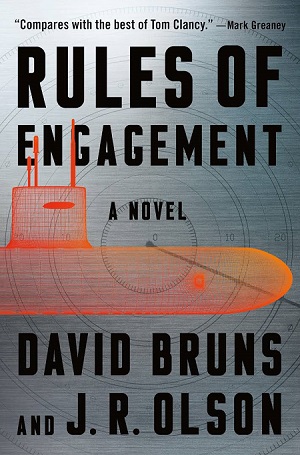Cyber Threats Explained Through Fiction - A SWJ Book Review of “Rules of Engagement: A Novel” by David Bruns and J.R. Olson
Franklin C. Annis

Rules of Engagement: A Novel at Amazon
It had been a long time since I read a work of fiction. Don’t get me wrong, there is tremendous value in fiction when it is written well. But for the last decade, I have been dedicating my free time to researching the military profession and have been heavily reading non-fiction. I will admit there are some incredible works of fiction that should be considered “required” reading for military officers. It is also to be noted that really any book can be made into a self-development activity if the reader takes the time to evaluate if he would make the same choices as the characters and consider how different choices might have impacted the storyline. But the bottom line is that the value of fiction is heavily dependent on how close of an analogy it is to real-life or possible real-life events. While many in the military writing community are currently reviewing the “Battle of Winterfell” (Game of Thrones) to conduct deep analysis of the tactics, I would find myself wanting materials that more closely resemble the battlefields that the U.S. Military may have to face tomorrow. I was looking for more modern technology and less dragons. This has caused me to largely prefer to study actual historical events and avoid works of fiction.
However, my avoidance of fiction recently came to an end when I was offered a chance to look at a book concerning cyberwarfare written by two Navy veterans. It was said to be written in the style of Tom Clancy. I thought that a book concerning cyber warfare would at least prove to be entertaining. What I found within this book goes far beyond entertainment as this novel could be used as a powerful tool for self and group development. “Rules of Engagement” by David Bruns and J.R. Olson provides a realistic narrative of a series of realistic events designed to throw major powers against each other.
The first thing I noticed about this book was it had remarkably clear language that could be understood by anyone from a novice to an expert. The main theme of the book is cyberwarfare. The equipment and methods are described in such a way that an untrained individual could understand the concept while still providing enough fancy terms and jargon to keep individuals with cyber or signal training interested. In this way it provides enough information to explain the broad concepts but leaves the reader with the appropriate terms if they wish to further study this area.
Just a few chapters into this book, I realized that many of the chapters displayed topics covered in the Department of Defense Information Awareness (IA) courses. Unlike the DoD courses that explains a threat and provides a historical example, this novel placed a string of these lessons together to explain how targeting multiple weakness could lead to the compromise of the information technology systems of an entire nation. I honestly wished that the military might consider utilizing this novel to provide a learning supplement to instruction to provide a more entertaining means of educating service members about the various ways our information technology systems might be attacked.
This book might be uniquely suited to be used during peer-learning groups or “book clubs.” The chapters are short, and most are “self-contained” to provide some useful lesson. In this way, the book could be said to be a collection of useful vignettes. I could imagine a group of service members reading and discussing a couple chapters at a time to determine what they would do differently and if the threat described in the chapter could apply to their organization.
This book is an exciting read. It has everything from dead hookers, to submarine warfare, to SEAL teams, to ethical dilemmas, to modern geopolitical realities, to spy networks, to sinking aircraft carriers, to near nuclear war. I found the vast majority of this book to be highly realistic. In some regards, this book serves as a frightening wakeup call to how much political and military tension exists in the modern world and how chains of little events could result in catastrophic conflicts. While there are a couple events in this novel that would be highly unlikely, they serve to complete the story arc and do not overly distract for the multiple valuable lessons within this book.
In the end, I would highly recommend this book for anyone interested more in cyberwarfare and damage this type of warfare could cause. This would be an excellent novel for service members and as an Army veteran, I found it remarkably refreshing to enjoy a story through a Navy “lens.” David Bruns and J.R. Olson did a remarkable job with this novel and definitely deserve to be compared to “the best of Tom Clancy.” This is the type of novel that will leave you wishing for a sequel. So, if your book club is looking for its next read or you are interested in the devastating impact cyberwarfare could have, I highly encourage you to pick up a copy.
For those interested, I had the opportunity to interview David Bruns and J.R. Olson to discuss cyberwarfare and the use of military fiction for self-development. The interview contains a lot of useful information for anyone that might be interested in trying their hand at writing a military thriller. The interview is available here.
